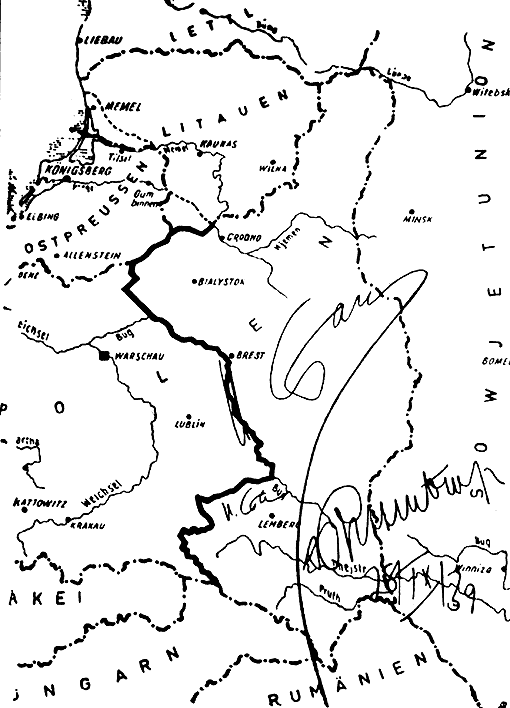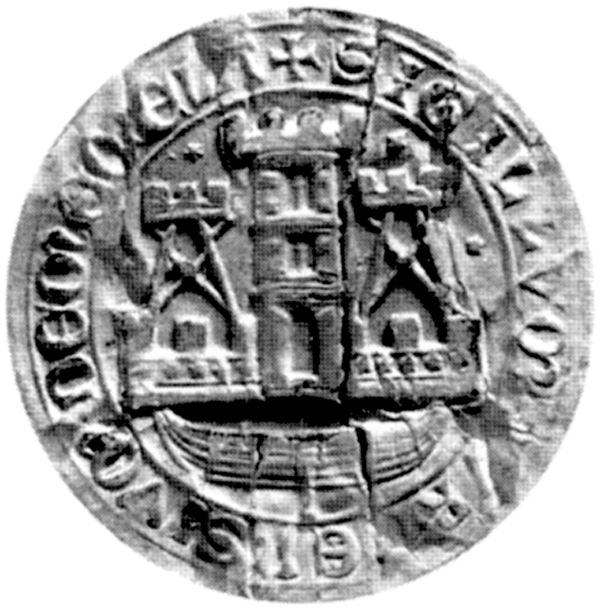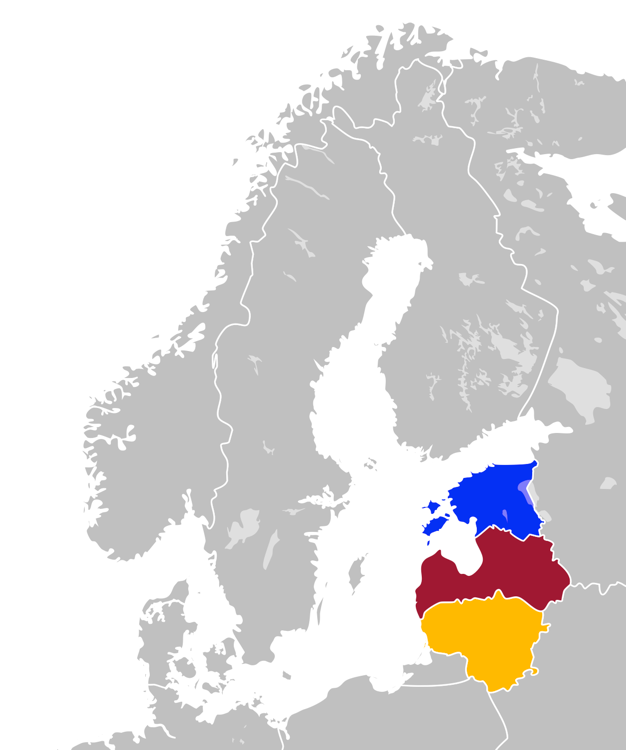|
Soviet–Lithuanian Mutual Assistance Treaty
The Soviet–Lithuanian Mutual Assistance Treaty ( lt, Lietuvos-Sovietų Sąjungos savitarpio pagalbos sutartis) was a bilateral treaty signed between the Soviet Union and Lithuania on October 10, 1939. According to provisions outlined in the treaty, Lithuania would acquire about one fifth of the Vilnius Region, including Lithuania's historical capital, Vilnius, and in exchange would allow five Soviet military bases with 20,000 troops to be established across Lithuania. In essence the treaty with Lithuania was very similar to the treaties that the Soviet Union signed with Estonia on September 28, and with Latvia on October 5. According to official Soviet sources, the Soviet military was strengthening the defenses of a weak nation against possible attacks by Nazi Germany. The treaty provided that Lithuania's sovereignty would not be affected. However, in reality the treaty opened the door for the first Soviet occupation of Lithuania and was described by ''The New York Times'' ... [...More Info...] [...Related Items...] OR: [Wikipedia] [Google] [Baidu] |
Soviet Union
The Soviet Union,. officially the Union of Soviet Socialist Republics. (USSR),. was a List of former transcontinental countries#Since 1700, transcontinental country that spanned much of Eurasia from 1922 to 1991. A flagship communist state, it was nominally a Federation, federal union of Republics of the Soviet Union, fifteen national republics; in practice, both Government of the Soviet Union, its government and Economy of the Soviet Union, its economy were highly Soviet-type economic planning, centralized until its final years. It was a one-party state governed by the Communist Party of the Soviet Union, with the city of Moscow serving as its capital as well as that of its largest and most populous republic: the Russian Soviet Federative Socialist Republic, Russian SFSR. Other major cities included Saint Petersburg, Leningrad (Russian SFSR), Kyiv, Kiev (Ukrainian Soviet Socialist Republic, Ukrainian SSR), Minsk (Byelorussian Soviet Socialist Republic, Byelorussian SSR), Tas ... [...More Info...] [...Related Items...] OR: [Wikipedia] [Google] [Baidu] |
Żeligowski's Mutiny
Żeligowski's Mutiny ( pl, bunt Żeligowskiego, also ''żeligiada'', lt, Želigovskio maištas) was a Polish false flag operation led by General Lucjan Żeligowski in October 1920, which resulted in the creation of the Republic of Central Lithuania. Polish Chief of State (Poland), Chief of State Józef Piłsudski surreptitiously ordered Żeligowski to carry out the operation, and revealed the truth only several years afterwards. The area was formally annexed by Second Polish Republic, Poland in 1922 and recognized by the Conference of Ambassadors as Polish territory in 1923. The decision was not recognized by Lithuania, which continued to claim Vilnius and the Vilnius Region, and by the Soviet Union.Timothy Snyder, ''The Reconstruction of Nations: Poland, Ukraine, Lithuania, Belarus, 1569–1999'', p. 78, Yale University Press, New Haven @ London 2003, . Background In late 1920, the Polish-Soviet War was ending with the Soviets defeated at the Battle of Warsaw (1920), Battle of W ... [...More Info...] [...Related Items...] OR: [Wikipedia] [Google] [Baidu] |
Invasion Of Poland (1939)
The invasion of Poland (1 September – 6 October 1939) was a joint attack on the Republic of Poland by Nazi Germany and the Soviet Union which marked the beginning of World War II. The German invasion began on 1 September 1939, one week after the signing of the Molotov–Ribbentrop Pact between Germany and the Soviet Union, and one day after the Supreme Soviet of the Soviet Union had approved the pact. The Soviets invaded Poland on 17 September. The campaign ended on 6 October with Germany and the Soviet Union dividing and annexing the whole of Poland under the terms of the German–Soviet Frontier Treaty. The invasion is also known in Poland as the September campaign ( pl, kampania wrześniowa) or 1939 defensive war ( pl, wojna obronna 1939 roku, links=no) and known in Germany as the Poland campaign (german: Überfall auf Polen, Polenfeldzug). German forces invaded Poland from the north, south, and west the morning after the Gleiwitz incident. Slovak military forces a ... [...More Info...] [...Related Items...] OR: [Wikipedia] [Google] [Baidu] |
Klaipėda
Klaipėda (; ; german: Memel; pl, Kłajpeda; russian: Клайпеда; sgs, Klaipieda) is a city in Lithuania on the Baltic Sea coast. The capital of the eponymous county, it is the third largest city and the only major seaport in Lithuania. The city has a complex recorded history, partially due to the combined regional importance of the usually ice-free Port of Klaipėda at the mouth of the river . Located in the region of Lithuania Minor, at various times, it was a part of the Polish–Lithuanian Commonwealth, Prussia and Germany until the 1919 Treaty of Versailles. As a result of the 1923 Klaipėda Revolt it was annexed by Lithuania and has remained with Lithuania to this day, except between 1939 and 1945 when it was occupied by Germany following the 1939 German ultimatum to Lithuania. The population has migrated from the city to its suburbs and hinterland. The number of inhabitants of Klaipėda city shrank from 202,929 in 1989 to 162,360 in 2011, but the urban ... [...More Info...] [...Related Items...] OR: [Wikipedia] [Google] [Baidu] |
1939 German Ultimatum To Lithuania
The 1939 German ultimatum to Lithuania was an oral ultimatum which Joachim von Ribbentrop, Foreign Minister of Nazi Germany, presented to Juozas Urbšys, Foreign Minister of Lithuania on 20 March 1939. The Germans demanded that Lithuania give up the Klaipėda Region (also known as the Memel Territory) which had been detached from Germany after World War I, or the Wehrmacht would invade Lithuania and the ''de facto'' Lithuanian capital Kaunas would be bombed. The Lithuanians had been expecting the demand after years of rising tension between Lithuania and Germany, increasing pro-Nazi propaganda in the region, and continued German expansion. It was issued just five days after the Occupation of Czechoslovakia by Nazi Germany, Nazi occupation of Czechoslovakia. The 1924 Klaipėda Convention had guaranteed the protection of the ''status quo'' in the region, but the four signatories to that convention did not offer any material assistance. The United Kingdom and France followed a policy ... [...More Info...] [...Related Items...] OR: [Wikipedia] [Google] [Baidu] |
Baltic States
The Baltic states, et, Balti riigid or the Baltic countries is a geopolitical term, which currently is used to group three countries: Estonia, Latvia, and Lithuania. All three countries are members of NATO, the European Union, the Eurozone, and the OECD. The three sovereign states on the eastern coast of the Baltic Sea are sometimes referred to as the "Baltic nations", less often and in historical circumstances also as the "Baltic republics", the "Baltic lands", or simply the Baltics. All three Baltic countries are classified as high-income economies by the World Bank and maintain a very high Human Development Index. The three governments engage in intergovernmental and parliamentary cooperation. There is also frequent cooperation in foreign and security policy, defence, energy, and transportation. The term "Baltic states" ("countries", "nations", or similar) cannot be used unambiguously in the context of cultural areas, national identity, or language. While the majori ... [...More Info...] [...Related Items...] OR: [Wikipedia] [Google] [Baidu] |
Spheres Of Influence
In the field of international relations, a sphere of influence (SOI) is a spatial region or concept division over which a state or organization has a level of cultural, economic, military or political exclusivity. While there may be a formal alliance or other treaty obligations between the influenced and influencer, such formal arrangements are not necessary and the influence can often be more of an example of soft power. Similarly, a formal alliance does not necessarily mean that one country lies within another's sphere of influence. High levels of exclusivity have historically been associated with higher levels of conflict. In more extreme cases, a country within the "sphere of influence" of another may become a subsidiary of that state and serve in effect as a satellite state or ''de facto'' colony. This was the case with the Soviet Union and its Eastern Bloc after World War II. The system of spheres of influence by which powerful nations intervene in the affairs of others co ... [...More Info...] [...Related Items...] OR: [Wikipedia] [Google] [Baidu] |
Molotov–Ribbentrop Pact
The Molotov–Ribbentrop Pact was a non-aggression pact between Nazi Germany and the Soviet Union that enabled those powers to partition Poland between them. The pact was signed in Moscow on 23 August 1939 by German Foreign Minister Joachim von Ribbentrop and Soviet Foreign Minister Vyacheslav Molotov and was officially known as the Treaty of Non-Aggression between Germany and the Union of Soviet Socialist Republics. Unofficially, it has also been referred to as the Hitler–Stalin Pact, Nazi–Soviet Pact or Nazi–Soviet Alliance (although it was not a formal alliance). The establishment of the treaty was preceded by Soviet efforts to form a tripartite alliance with Britain and France. The Soviet Union began negotiations with Germany on 22 August, one day after talks broke down with Britain and France, and the Molotov–Ribbentrop pact was signed the next day. Its clauses provided a written guarantee of peace by each party towards the other and a commitment that declared that nei ... [...More Info...] [...Related Items...] OR: [Wikipedia] [Google] [Baidu] |
Soviet–Lithuanian Non-Aggression Pact
Soviet–Lithuanian Non-Aggression Pact (Lithuanian: ''Lietuvos–SSRS nepuolimo sutartis'') was a non-aggression pact, signed between the Soviet Union and Lithuania on September 28, 1926. The pact confirmed all basic provisions of the Soviet–Lithuanian Peace Treaty of 1920. The Soviet Union continued to recognize Vilnius and Vilnius Region to Lithuania, despite the fact that the territories were under Polish control since the Żeligowski's Mutiny in 1920. It also recognized Lithuania's interests in the Klaipėda Region. In exchange Lithuania agreed not to join any alliances directed against the Soviet Union, which meant international isolation at the time when Soviet Union was not a member of the League of Nations. Ratifications were exchanged in Kaunas on November 9, 1926, and the pact became effective on the same day. The pact was registered in ''League of Nations Treaty Series'' on March 4, 1927. The pact was initiated by Lithuanians who sought a new direction in the foreign ... [...More Info...] [...Related Items...] OR: [Wikipedia] [Google] [Baidu] |
Klaipėda Revolt
The Klaipėda Revolt took place in January 1923 in the Klaipėda Region (also known as the Memel Territory or ). The region, located north of the Neman River, was detached from East Prussia, German Empire by the Treaty of Versailles and became a mandate of the League of Nations. It was placed under provisional French administration until a more permanent solution could be worked out. Lithuania wanted to unite with the region (part of Lithuania Minor) due to its large Lithuanian-speaking minority of Prussian Lithuanians and major port of Klaipėda (Memel) – the only viable access to the Baltic Sea for Lithuania. As the Conference of Ambassadors favored leaving the region as a free city, similar to the Free City of Danzig, the Lithuanians organized and staged a revolt. Presented as an uprising of the local population, the revolt met little resistance from either the German police or the French troops. The rebels established a pro-Lithuanian administration, which petitioned to u ... [...More Info...] [...Related Items...] OR: [Wikipedia] [Google] [Baidu] |
Klaipėda Region
The Klaipėda Region ( lt, Klaipėdos kraštas) or Memel Territory (german: Memelland or ''Memelgebiet'') was defined by the 1919 Treaty of Versailles in 1920 and refers to the northernmost part of the German province of East Prussia, when as Memelland it was put under the administration of the Entente's Council of Ambassadors. The Memel Territory, together with other areas severed from Germany (the Saar and Danzig) was to remain under the control of the League of Nations until a future day when the people of these regions would be allowed to vote on whether the land would return to Germany or not. Today, the former Memel Territory is controlled by Lithuania as part of Klaipėda and Tauragė counties. Historical overview In 1226 Duke Konrad I of Masovia requested assistance against the Prussians and other Baltic tribes, including the Skalvians who lived along the Neman (Memel) River. In March 1226, Holy Roman Emperor Frederick II issued the Golden Bull of Rimini, wh ... [...More Info...] [...Related Items...] OR: [Wikipedia] [Google] [Baidu] |
League Of Nations
The League of Nations (french: link=no, Société des Nations ) was the first worldwide Intergovernmental organization, intergovernmental organisation whose principal mission was to maintain world peace. It was founded on 10 January 1920 by the Paris Peace Conference (1919–1920), Paris Peace Conference that ended the World War I, First World War. The main organization ceased operations on 20 April 1946 but many of its components were relocated into the new United Nations. The League's primary goals were stated in Covenant of the League of Nations, its Covenant. They included preventing wars through collective security and Arms control, disarmament and settling international disputes through negotiation and arbitration. Its other concerns included labour conditions, just treatment of native inhabitants, Human trafficking, human and Illegal drug trade, drug trafficking, the arms trade, global health, prisoners of war, and protection of minorities in Europe. The Covenant of th ... [...More Info...] [...Related Items...] OR: [Wikipedia] [Google] [Baidu] |







